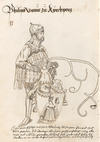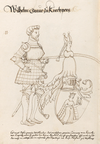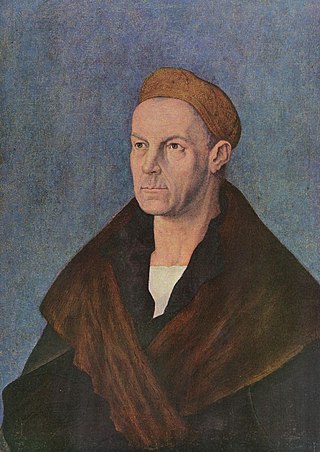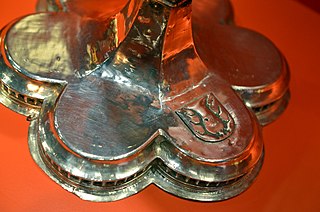| Ruler | Born | Reign | Ruling part | Consort | Death | Notes |
|---|
| Hartmann I |  | 1063
? | c.1090 – 1125 | County of Kirchberg | Unknown
two children | 1125
aged 61–62 | Brothers and founders of the family and the county. They also founded Wiblingen Abbey. |
| Otto I | c.1065
? | c.1090 – 1107 | Unknown
one child | 1107
aged c.41-42 |
| Hartmann II | | c.1095
First son of Hartmann I | 1125 – 1170 | County of Kirchberg | Unknown
no children | 1170
aged c.74-75 | Children of Hartmann I, ruled jointly. |
| Eberhard I | | 1099
Second son of Hartmann I | 1125 – 1166 | Unknown
five children | 1166
aged 66–67 |
| Hartmann III | | 1119
First son of Eberhard I | 1170 – 1198 | County of Kirchberg-Brandenburg | Unknown
three children | 1198
aged 78–79 | Children of Hartmann II, divided their inheritance. |
| Otto II | | c.1120
Second son of Eberhard I | 1170 – 1188 | County of Kirchberg | Unknown
five children | 1188
aged 57–58 |
| Eberhard II | | c.1160?
First son of Otto II | 1188 – 27 August 1240 | County of Kirchberg | Bertha of Alpeck
three children | 27 August 1240
aged 79-80? | Children of Otto II and Hartmann III, ruled jointly. |
| Otto III | | c.1160?
Second son of Otto II | c.1198 | Unmarried | 1198
aged 37-38? |
| Hartmann IV | | 1146?
Son of Hartmann III | 1198 – 1215 | County of Kirchberg-Brandenburg | ? of Korsch-Eichelberg
one child | 1215
aged 68–69 | Left only a daughter, and his inheritance went to his nephew, Otto IV. |
| Otto IV | | c.1190
First son of Eberhard II and Bertha of Alpeck | 1215 – 1220 | County of Kirchberg-Brandenburg | Unknown
two children | 1220
aged 29–30 | |
| Otto V | | c.1210?
First son of Otto IV | 1220 – 23 July 1296 | County of Kirchberg-Brandenburg | ? of Maschetten
one child | 23 July 1296
aged 85–86? | Children of Otto IV, ruled jointly. After his brother's death, Otto V associated his own son Otto VI and nephew Otto VII (son of Hartmann V) to the co-rulership. |
| Hartmann V | | c.1210?
Second son of Otto IV | 1220 – 1246 | ? of Wurttemberg
four children | 1246
aged 35–36? |
| Otto VI | | c.1230?
Son of Otto V | 1246 – 23 July 1281 | ? of Gundelfingen
three children | 23 July 1281
aged 50–51? |
| Otto VII | | c.1230?
Son of Hartmann V | 1246 – 1280 | Unmarried | 1280
aged 49–50? |
| Conrad I |  | c.1200
Second son of Eberhard II and Bertha of Alpeck | 27 August 1240 – 1268 | County of Kirchberg | Bertha of Eberstahl
(1201-1264)
two children | 1268
aged 67–68? | |
| Conrad II | 1229
First son of Conrad I and Bertha of Eberstahl | 1268 – 2 February 1286 | County of Kirchberg | Elisabeth of Eichen
(d.c.1280)
three children | 2 February 1286
aged 56–57 | Children of Conrad I, divided their inheritance. |
| Eberhard III | | 1231
Second son of Conrad I and Bertha of Eberstahl | 1268 – 1283 | County of Kirchberg-Wullenstetten | Uta of Neuffen
five children | 1283
aged 51–52 |
| Conrad III the Elder | | 1268
Son of Eberhard III and Uta of Neuffen | 1283 – 1326 | County of Kirchberg-Wullenstetten | Bertha of Vaz
(d.1335)
three children | 1326
aged 57–58 | |
| Conrad IV | | c.1250
Son of Conrad II and Elisabeth of Eichen | 2 February 1286 – 30 March 1315 | County of Kirchberg | Unknown
four children | 30 March 1315
aged 64–65 | |
| Hartmann VI | | c.1250
Son of Otto VI and ? of Gundelfingen | 23 July 1296 – 23 April 1298 | County of Kirchberg-Brandenburg | Sophia of Wangen
(d.c.1330)
four children | 23 April 1298
aged 47–48 | After his death in battle, Kirchberg-Brandenburg was annexed to the Holy Roman Empire. |
| Kirchberg-Brandenburg was annexed to the Holy Roman Empire |
| Conrad V | | c.1270
First son of Conrad IV | 30 March 1315 – 1315 | County of Kirchberg | Anna of Taufers
(d.21 June 1351)
three children | 1315 (after 30 March?)
aged 44–45 | Children of Conrad IV, ruled jointly. |
| Bruno [5] | | c.1280?
Second son of Conrad IV | 30 March 1315 – 1356 | Liutgard of Eichelburg
(d.30 March 1356)
four children | 1356
aged 75–76? |
| Eberhard IV | | c.1280
Son of Conrad III and Bertha of Vaz | 1326 | County of Kirchberg-Wullenstetten | Liutgard
two children | c.1326
aged 45-46 | |
| William II [6] | | c.1323?
Son of Eberhard IV and Liutgard | 1326 – 1 September 1370 | County of Kirchberg-Wullenstetten | Anna of Eichen
(d.1369)
five children | 1 September 1370
aged 46-47 | |
| Conrad VI | | c.1300?
First son of Bruno and Liutgard of Eichelburg | 1356 – 1367 | County of Kirchberg | Unmarried | 1367
aged 66–67 | Children of Bruno, ruled jointly. After their deaths, Kirchberg was inherited by William's daughter Agnes, and the County of Matsch. |
| William I | | c.1300?
Second son of Bruno and Liutgard of Eichelburg | 1356 – 10 August 1366 | Agnes of Teck
1336
(d.23 September 1384)
one child | 10 August 1366
aged 65–66 |
| Agnes | | c.1340?
Daughter of William I and Agnes of Teck | 1367 – 12 March 1407 | County of Kirchberg
(from 1390 in only parts of Kirchberg) | Ulrich IV, Lord of Matsch
six children | 12 March 1407
aged 66–67 | Heiress of Kirchberg, which was transferred to the House of Matsch; however, the family returned much (though not all) of Kirchberg to the original family. |
| Kirchberg was annexed to the House of Matsch, though parts of it returned in |
| Conrad VII |  | 1354
First son of William II and Anna of Eichen | 1 September 1370 – 17 January 1417 | County of Kirchberg-Wullenstetten | Anna of Hohenberg-Wildberg
(c.1360-1421)
c.1380
four children | 17 January 1417
aged 62–63 | Children of William II, ruled possibly jointly. Eberhard may have abdicated to pursue a religious career, and became Bishop of Augsburg. |
| Eberhard V | | c.1360
Second son of William II and Anna of Eichen | 1 September 1370 – 1404 | Unmarried | 12 August 1413
Wiblingen
aged 52–53 |
| Eberhard VI |  | c.1385
Son of Conrad VII and Anna of Hohenberg-Wildberg | 17 January 1417 – 15 May 1440 | County of Kirchberg
(in Wullenstetten until 1434; in the whole county since 1434) | Agnes of Werdenberg-Bludenz
(d.1436)
1415
five children | 15 May 1440
aged 54–55 | Despite having already inherited the older Kirchberg inheritance (given by the Matsch family after the pledge of 1390, he was only recognized as possessor of the entirety of the county in 1434. |
| Eberhard VII |  | c.1415
First son of Eberhard VI and Agnes of Werdenberg-Bludenz | 15 May 1440 – 4 July 1472 | County of Kirchberg | Kunigunde of Wertheim
(d.1481)
eight children | 4 July 1472
aged 56–57 | Children of Eberhard VI, ruled jointly. It's not certain if Conrad VIII associated his son Conrad IX. |
| Conrad VIII |  | c.1415
Second son of Eberhard VI and Agnes of Werdenberg-Bludenz | 15 May 1440 – 5 June 1470 | Anna of Fürstenberg-Baar
(c.1426-1481)
five children | 5 June 1470
aged 54–55 |
| Conrad IX |  | c.1440?
First son of Conrad VIII and Anna of Fürstenberg-Baar | 1450? – 24 May 1460 | 24 May 1460
aged 19–20? | Unmarried |
| Philip |  | c.1455?
Son of Eberhard VII and Kunigunde of Wertheim | 4 July 1472 – 20 August 1510 | County of Kirchberg | Elisabeth of Schonburg
(d.20 July 1491)
three children | 20 August 1510
aged 54–55 | Cousins, ruled jointly. Indebted, William sold his part of the land to Bavaria in 1481, and Philip may have done the same with some of his inheritance. The core Kirchberg domains were, however, retained by Philip until his own death. In his own lifetime he saw the Fugger family being nominated as Counts of Kirchberg (1507), and they may have succeeded him after his death. |
| William III |  | c.1440
Second son of Conrad VIII and Anna of Fürstenberg-Baar | 4 July 1472 – 1481 | Elisabeth of Erbach-Erbach
no children | 22 March 1488
aged 57–58 |



























